Wende Museum
| The Wende Museum and Archive of the Cold War | |
|---|---|
| Established | 2002 |
| Location | 5741 Buckingham Parkway, Suite E, Culver City, California |
| Type | Cultural Museum |
| Director | Justinian Jampol |
| Public transit access | Bus: 3 Culver CityBus and 108 and 358 Metro Local at Slauson Avenue/Buckingham Parkway |
| Website | http://www.wendemuseum.org |
The Wende Museum and Archive of the Cold War is a museum and educational institution in Culver City, California.[1] It was founded in 2002 by Justinian Jampol and has a collection of more than 75,000 objects of visual and material culture from East Germany and the former Eastern Bloc.[2] In November 2012, the City Council of Culver City voted unanimously to approve a 75-year lease of the former United States National Guard Armory in Culver City as the Wende Museum’s permanent home. The Armory was built by the National Guard in 1950 as the Cold War began to escalate and was decommissioned in March 2011. The Museum is expected to open at the Armory site in late-2014 following renovations.[3][4]
Overview
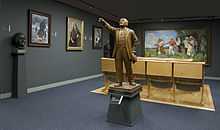
“Wende” is a German word meaning “turning point," a period of transition and change between the toppling of the Berlin Wall in 1989 and the collapse of the Soviet Union in 1991.
The Museum’s East German collections is the subject of a major Taschen publication, published in 2014.[5] [6]
Collections
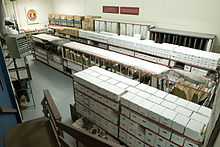
The Wende’s collections are a resource for the vanishing cultural and political history of East Germany (Germany Democratic Republic, also referred to as GDR) and all Warsaw Pact countries (Albanian, Bulgaria, Czechoslovakia, East Germany, Hungary, Poland, Romania and USSR).[7] They focus on the museum and archival models to support emerging fields of academic study in visual and cultural history. The Museum is a leader in promoting exploration of the cold war era, marked by political and military tensions between the United States and its NATO allies on one side and the communist world led by the Soviet Union and its satellite states on the other.[8]
The Wende Museum has more than 75,000 holdings from Eastern Europe and the Soviet Union during the Cold War period: 1945 to 1991.[9] The Museum’s ever-increasing collection widely ranges from consumer products (e.g., computers, radios, records, toiletries, foodstuff) to works of art in all media (e.g., paintings, drawings, sculptures, graphics, photographs), iconic political symbols (e.g., statuary, medals, flags, uniforms, commemorative gifts), and archives — including a substantial gift from East German leader Erich Honecker’s estate — and some 3,500 16 mm documentary and educational films from the GDR.[10] They have large collections of furniture, flags and banners, Communist folk art, menus, family albums, and design items. The Museum recently acquired a significant collection of Hungarian Cold War-era artifacts.[11]
The Wende Museum acquired eleven original segments of the Berlin Wall, including ten installed in front of 5900 Wilshire Boulevard, the longest stretch of the Wall in the United States. The eleventh, painted by Berlin-based Thierry Noir, stands in front of the Museum’s headquarters in Culver City.
Although comprehensive in nature, the collection shows notable strength in four areas:
- Materials originating from East Germany, an extinct society, with more than 50% of the collection from the GDR;
- Items used in everyday life and holdings capturing lived experience;
- Materials that document “Wende Moments,” junctures in Cold War history marked by extreme change—beginnings, endings and transformative events such as the formation of the Warsaw Pact, the fall of the Berlin Wall, German reunification, the collapse of the Soviet Union and the evolution of former communist countries to members of a pan-European union; and
- Examples of official texts, artifacts, and artworks.
The Albanian Human Rights Project recently deposited at The Wende Museum more than 40 filmed historical witness interviews with survivors of the Albanian communist purges, many of whom lived in prisons and forced labor camps for as long as 40 years.
The Museum’s collections have been exhibited, or are currently on display, in a number of other museums and institutions including the Los Angeles County Museum of Art, Imperial War Museum (London), Ronald Reagan Presidential Library & Museum (Simi Valley, CA), Gerald Ford Presidential Library (Ann Arbor, MI), the Goethe Institute (Washington, D.C.), the International Spy Museum (Washington, D.C.), and ESMoA (El Segundo, CA).[12]
Programs
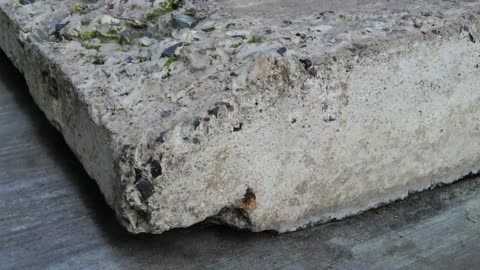
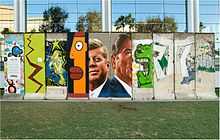
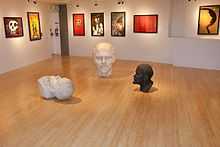
The Museum initiates programs that provide resources and opportunities for individual interpretation of the past and for discovering the global implications of the Cold War today. The Museum also uses the period as a lens to explore parallels and metaphors that reflect on contemporary life, human behavior and creative expression.
- The Wall Project
- The Surveillance Project
- Across/ the Wall
- Deconstructing Perestroika
In 2009, the Wende Museum commemorated the 20th anniversary of the fall of the Berlin Wall with The Wall Project, which was called the most ambitious commemoration outside of Germany.[13] As part of the event, the Museum installed ten original segments of the Berlin Wall in front of 5900 Wilshire Blvd., the longest stretch of the Wall in the United States.[14] The original segments were paired with The Wall Across Wilshire, an artistic interpretation of the Wall painted by Shepard Fairey and graffiti artists working with ArtStorm, among other artists and the public.
As part of The Wall Project, the Western sides of the Berlin Wall pieces were painted by LA muralist Kent Twitchell, Thierry Noir, and emerging Los Angeles artists Farrah Karapetian and Marie Astrid Gonzalez.[15] In addition to the new works, one of the pieces retains the original painting by Berlin street artist Bimer, who is known for his bears.[16]
On November 13, 2011, the Museum unveiled Behind The Wall, a component of The Surveillance Project that brought together street artists D*Face, RETNA, and Herakut to paint the original east facing backs of the wall pieces on Wilshire Blvd.[17]
In 2011, as part of the Downtown Art Walk, the Museum mounted Across/ the Wall, an exhibition on the exterior wall of a downtown Los Angeles parking garage with high resolution reproductions of Soviet era portraits.[18] While street artists are exhibiting in museums, this ongoing street project brings museum art onto the streets of Los Angeles.
In collaboration with the Craft and Folk Art Museum in Los Angeles, The Wende Museum mounted Deconstructing Perestroika from January 28-May 6, 2012.[19] The exhibit showcased 24 original, hand-painted poster designs created by thirteen artists as visual responses to Mikhail Gorbachev’s transformative policies of Glasnost and Perestroika in the late 1980s. This exhibition, culled from the Museum’s Ferris Collection of 234 examples of avtorskii plakat, examined key political and cultural shifts that defined the era and that ultimately undermined the very foundation of Soviet ideology. In 2013, this exhibit traveled to the Natalie and James Thompson Art Gallery at San Jose State University.
In 2013, The Wende Museum contributed artifacts from their collection, including Russian vouchers, to Jeremy Deller's solo exhibition in the British Pavilion at the Venice Biennale.[20]
References
- ↑ Wende Museum History
- ↑ "Humanities Magazine - California's Cold War Museum: An Exceptional Look at Everyday Life at the Wende Museum - NEH.gov". National Endowment for the Humanities. May–June 2011.
- ↑ "Culver City's Cold War museum is hoping for a victory - LATimes.com". Los Angeles Times. November 11, 2012.
- ↑ "Culver City approves Cold War museum's lease for new home - LATimes.com". Los Angeles Times. November 14, 2012.
- ↑ artdaily.org article "Wende Museum's Cold War Visual Archive to be Subject of Major Taschen Book"
- ↑ "Beyond the Wall: Art and artifacts from the GDR"
- ↑ "Humanities Magazine - California's Cold War Museum: An Exceptional Look at Everyday Life at the Wende Museum - NEH.gov". National Endowment for the Humanities. May–June 2011.
- ↑ The Atlantic "Cold War Relics: The Wende Museum Saves Communist Design"
- ↑ Wende Museum Collections
- ↑ The Atlantic - Cold War Relics: The Wende Museum Saves Communist Design - theatlantic.com
- ↑ The Wall Street Journal - An Auction for Budapest's Bourgeoisie Puts Lenin on the Communist Block - WSJ.com
- ↑ Easy Reader News "Here Today, Gone Tomorrow – “Fame,” in El Segundo, explores the renowned and the forgotten in a new exhibition"
- ↑ Los Angeles Times - Berlin Wall's fall will be memorialized across Wilshire
- ↑ PRI's The World - Preserving the Cold War in Sunny California
- ↑ Wall Street Journal - Angelenos Tear Down a Facsimile
- ↑ The Wende Museum - The Wall Project
- ↑ Los Angeles Times - United through a Berlin Wall artwork
- ↑ Art Walk - The Wende Museum
- ↑ Los Angeles Times - Poster art exhibit recalls end of Soviet era
- ↑ The Guardian - Jeremy Deller shows a 'wistfully aggressive' Britain at Venice Biennale